FIAT ULYSSE 2007 2.G Owners Manual
Manufacturer: FIAT, Model Year: 2007, Model line: ULYSSE, Model: FIAT ULYSSE 2007 2.GPages: 254, PDF Size: 3.42 MB
Page 121 of 254
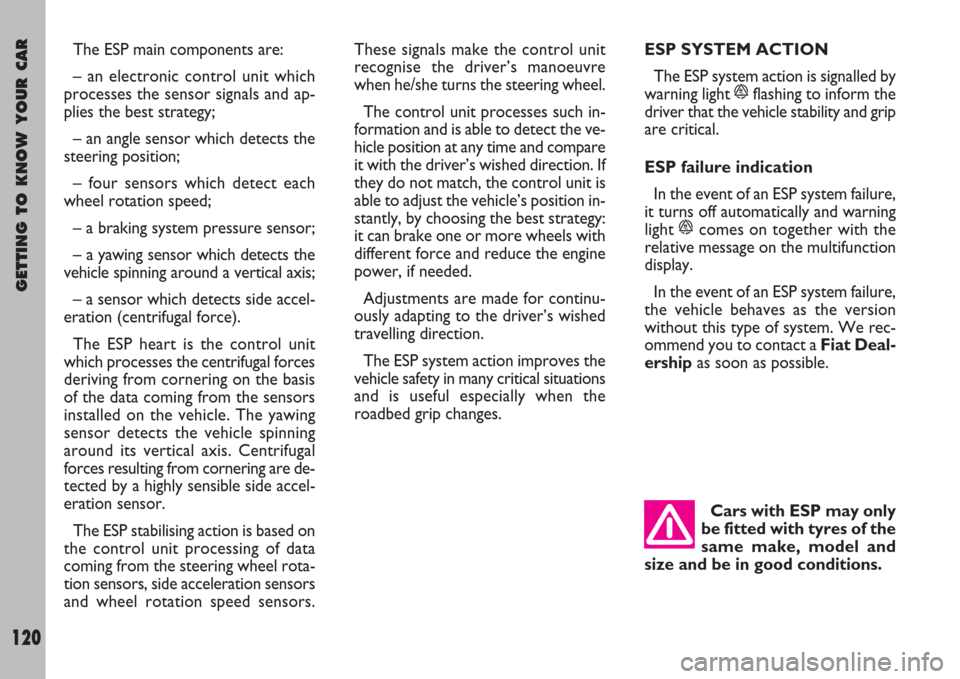
Cars with ESP may only
be fitted with tyres of the
same make, model and
size and be in good conditions.
GETTING TO KNOW YOUR CAR
120
ESP SYSTEM ACTION
The ESP system action is signalled by
warning light
ñflashing to inform the
driver that the vehicle stability and grip
are critical.
ESP failure indication
In the event of an ESP system failure,
it turns off automatically and warning
light
ñcomes on together with the
relative message on the multifunction
display.
In the event of an ESP system failure,
the vehicle behaves as the version
without this type of system. We rec-
ommend you to contact a Fiat Deal-
ership as soon as possible. The ESP main components are:
– an electronic control unit which
processes the sensor signals and ap-
plies the best strategy;
– an angle sensor which detects the
steering position;
– four sensors which detect each
wheel rotation speed;
– a braking system pressure sensor;
– a yawing sensor which detects the
vehicle spinning around a vertical axis;
– a sensor which detects side accel-
eration (centrifugal force).
The ESP heart is the control unit
which processes the centrifugal forces
deriving from cornering on the basis
of the data coming from the sensors
installed on the vehicle. The yawing
sensor detects the vehicle spinning
around its vertical axis. Centrifugal
forces resulting from cornering are de-
tected by a highly sensible side accel-
eration sensor.
The ESP stabilising action is based on
the control unit processing of data
coming from the steering wheel rota-
tion sensors, side acceleration sensors
and wheel rotation speed sensors.These signals make the control unit
recognise the driver’s manoeuvre
when he/she turns the steering wheel.
The control unit processes such in-
formation and is able to detect the ve-
hicle position at any time and compare
it with the driver’s wished direction. If
they do not match, the control unit is
able to adjust the vehicle’s position in-
stantly, by choosing the best strategy:
it can brake one or more wheels with
different force and reduce the engine
power, if needed.
Adjustments are made for continu-
ously adapting to the driver’s wished
travelling direction.
The ESP system action improves the
vehicle safety in many critical situations
and is useful especially when the
roadbed grip changes.
Page 122 of 254
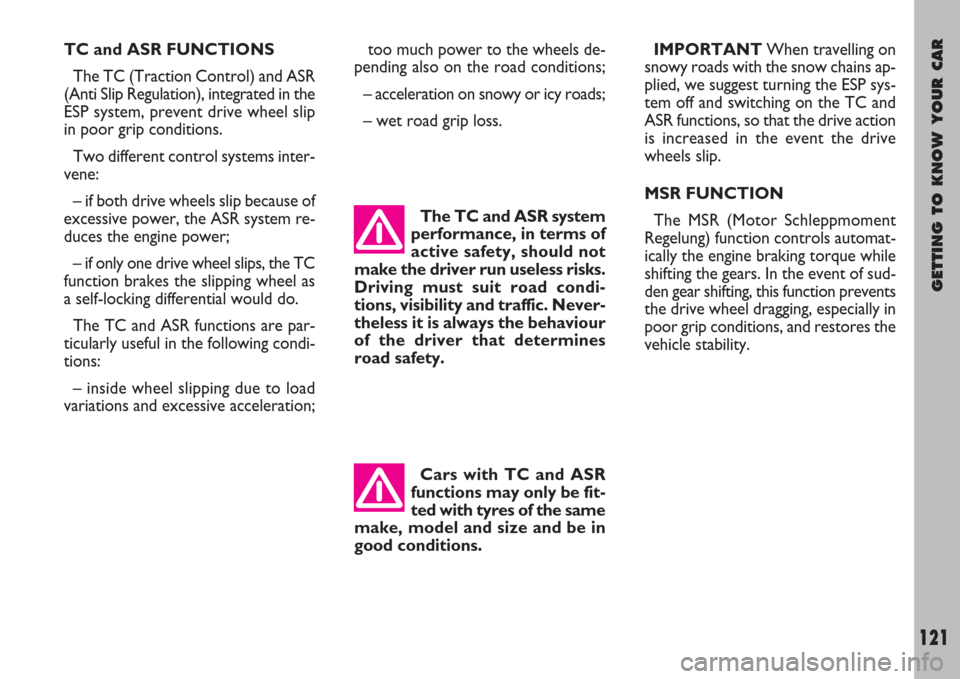
GETTING TO KNOW YOUR CAR
121
TC and ASR FUNCTIONS
The TC (Traction Control) and ASR
(Anti Slip Regulation), integrated in the
ESP system, prevent drive wheel slip
in poor grip conditions.
Two different control systems inter-
vene:
– if both drive wheels slip because of
excessive power, the ASR system re-
duces the engine power;
– if only one drive wheel slips, the TC
function brakes the slipping wheel as
a self-locking differential would do.
The TC and ASR functions are par-
ticularly useful in the following condi-
tions:
– inside wheel slipping due to load
variations and excessive acceleration;too much power to the wheels de-
pending also on the road conditions;
– acceleration on snowy or icy roads;
– wet road grip loss.
The TC and ASR system
performance, in terms of
active safety, should not
make the driver run useless risks.
Driving must suit road condi-
tions, visibility and traffic. Never-
theless it is always the behaviour
of the driver that determines
road safety.
Cars with TC and ASR
functions may only be fit-
ted with tyres of the same
make, model and size and be in
good conditions.IMPORTANTWhen travelling on
snowy roads with the snow chains ap-
plied, we suggest turning the ESP sys-
tem off and switching on the TC and
ASR functions, so that the drive action
is increased in the event the drive
wheels slip.
MSR FUNCTION
The MSR (Motor Schleppmoment
Regelung) function controls automat-
ically the engine braking torque while
shifting the gears. In the event of sud-
den gear shifting, this function prevents
the drive wheel dragging, especially in
poor grip conditions, and restores the
vehicle stability.
Page 123 of 254
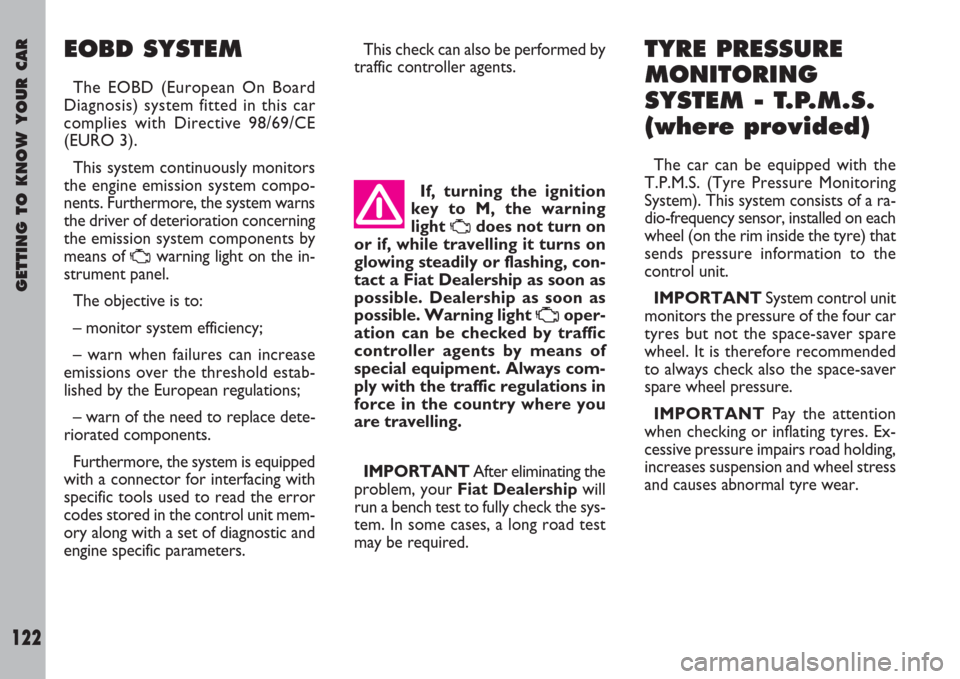
GETTING TO KNOW YOUR CAR
122
EOBD SYSTEM
The EOBD (European On Board
Diagnosis) system fitted in this car
complies with Directive 98/69/CE
(EURO 3).
This system continuously monitors
the engine emission system compo-
nents. Furthermore, the system warns
the driver of deterioration concerning
the emission system components by
means of
Uwarning light on the in-
strument panel.
The objective is to:
– monitor system efficiency;
– warn when failures can increase
emissions over the threshold estab-
lished by the European regulations;
– warn of the need to replace dete-
riorated components.
Furthermore, the system is equipped
with a connector for interfacing with
specific tools used to read the error
codes stored in the control unit mem-
ory along with a set of diagnostic and
engine specific parameters. This check can also be performed by
traffic controller agents.
If, turning the ignition
key to M, the warning
light
Udoes not turn on
or if, while travelling it turns on
glowing steadily or flashing, con-
tact a Fiat Dealership as soon as
possible. Dealership as soon as
possible. Warning light
Uoper-
ation can be checked by traffic
controller agents by means of
special equipment. Always com-
ply with the traffic regulations in
force in the country where you
are travelling.
IMPORTANTAfter eliminating the
problem, your Fiat Dealershipwill
run a bench test to fully check the sys-
tem. In some cases, a long road test
may be required.
TYRE PRESSURE
MONITORING
SYSTEM - T.P.M.S.
(where provided)
The car can be equipped with the
T.P.M.S. (Tyre Pressure Monitoring
System). This system consists of a ra-
dio-frequency sensor, installed on each
wheel (on the rim inside the tyre) that
sends pressure information to the
control unit.
IMPORTANTSystem control unit
monitors the pressure of the four car
tyres but not the space-saver spare
wheel. It is therefore recommended
to always check also the space-saver
spare wheel pressure.
IMPORTANTPay the attention
when checking or inflating tyres. Ex-
cessive pressure impairs road holding,
increases suspension and wheel stress
and causes abnormal tyre wear.
Page 124 of 254
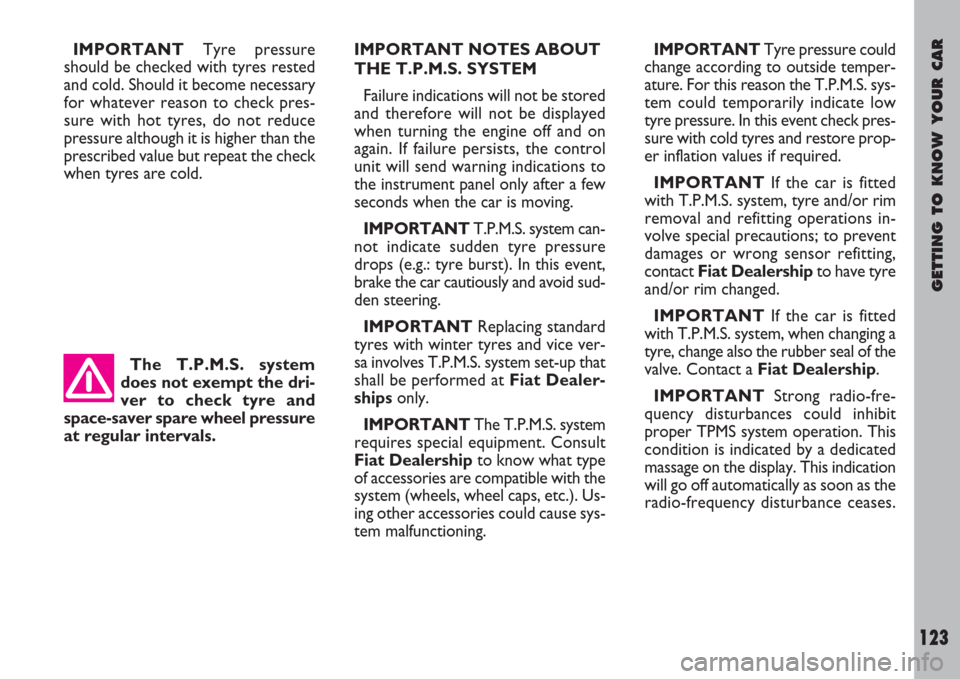
The T.P.M.S. system
does not exempt the dri-
ver to check tyre and
space-saver spare wheel pressure
at regular intervals.
GETTING TO KNOW YOUR CAR
123
IMPORTANTTyre pressure
should be checked with tyres rested
and cold. Should it become necessary
for whatever reason to check pres-
sure with hot tyres, do not reduce
pressure although it is higher than the
prescribed value but repeat the check
when tyres are cold.IMPORTANT NOTES ABOUT
THE T.P.M.S. SYSTEM
Failure indications will not be stored
and therefore will not be displayed
when turning the engine off and on
again. If failure persists, the control
unit will send warning indications to
the instrument panel only after a few
seconds when the car is moving.
IMPORTANTT.P.M.S. system can-
not indicate sudden tyre pressure
drops (e.g.: tyre burst). In this event,
brake the car cautiously and avoid sud-
den steering.
IMPORTANTReplacing standard
tyres with winter tyres and vice ver-
sa involves T.P.M.S. system set-up that
shall be performed at Fiat Dealer-
ships only.
IMPORTANT The T.P.M.S. system
requires special equipment. Consult
Fiat Dealership to know what type
of accessories are compatible with the
system (wheels, wheel caps, etc.). Us-
ing other accessories could cause sys-
tem malfunctioning.IMPORTANTTyre pressure could
change according to outside temper-
ature. For this reason the T.P.M.S. sys-
tem could temporarily indicate low
tyre pressure. In this event check pres-
sure with cold tyres and restore prop-
er inflation values if required.
IMPORTANTIf the car is fitted
with T.P.M.S. system, tyre and/or rim
removal and refitting operations in-
volve special precautions; to prevent
damages or wrong sensor refitting,
contact Fiat Dealership to have tyre
and/or rim changed.
IMPORTANTIf the car is fitted
with T.P.M.S. system, when changing a
tyre, change also the rubber seal of the
valve. Contact a Fiat Dealership.
IMPORTANT Strong radio-fre-
quency disturbances could inhibit
proper TPMS system operation. This
condition is indicated by a dedicated
massage on the display. This indication
will go off automatically as soon as the
radio-frequency disturbance ceases.
Page 125 of 254
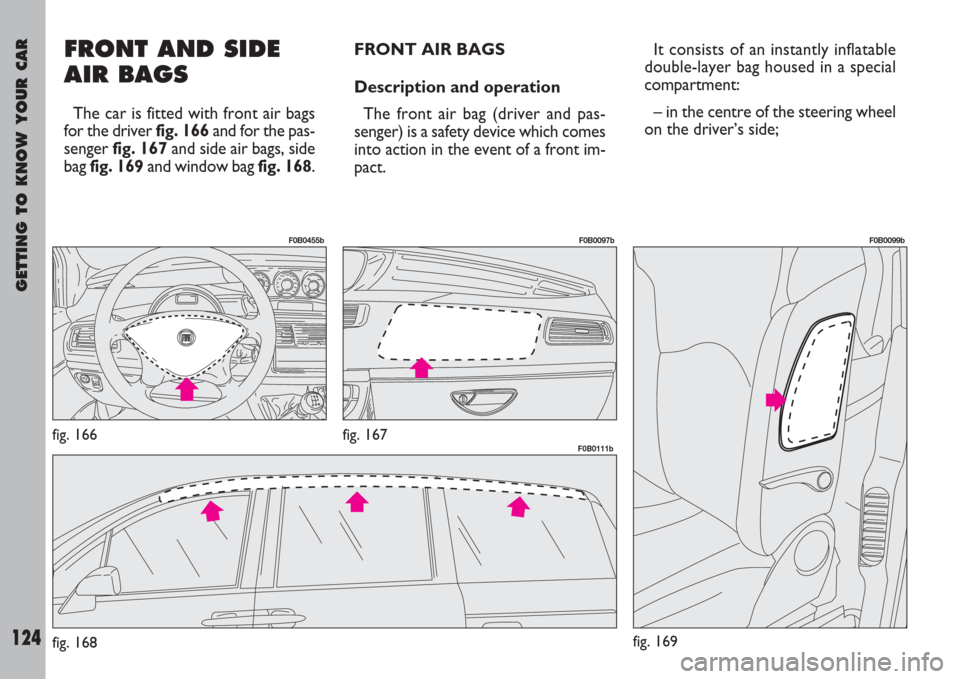
GETTING TO KNOW YOUR CAR
124fig. 168
F0B0111b
FRONT AND SIDE
AIR BAGS
The car is fitted with front air bags
for the driver fig. 166and for the pas-
senger fig. 167and side air bags, side
bag fig. 169and window bag fig. 168.FRONT AIR BAGS
Description and operation
The front air bag (driver and pas-
senger) is a safety device which comes
into action in the event of a front im-
pact.It consists of an instantly inflatable
double-layer bag housed in a special
compartment:
– in the centre of the steering wheel
on the driver’s side;
fig. 167
F0B0097b
fig. 169
F0B0099b
fig. 166
F0B0455b
Page 126 of 254
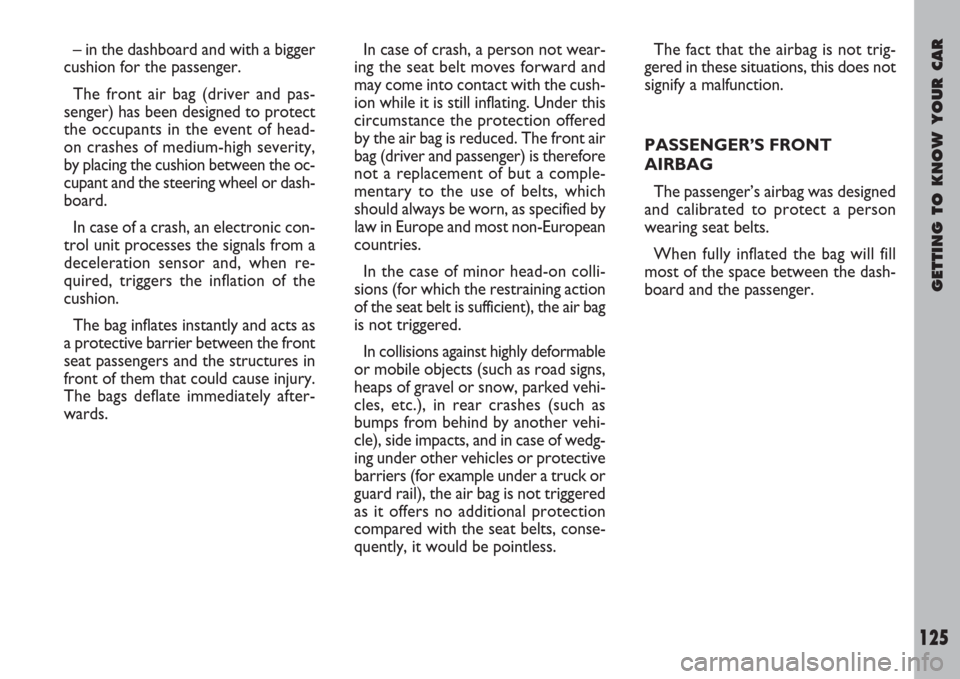
GETTING TO KNOW YOUR CAR
125
– in the dashboard and with a bigger
cushion for the passenger.
The front air bag (driver and pas-
senger) has been designed to protect
the occupants in the event of head-
on crashes of medium-high severity,
by placing the cushion between the oc-
cupant and the steering wheel or dash-
board.
In case of a crash, an electronic con-
trol unit processes the signals from a
deceleration sensor and, when re-
quired, triggers the inflation of the
cushion.
The bag inflates instantly and acts as
a protective barrier between the front
seat passengers and the structures in
front of them that could cause injury.
The bags deflate immediately after-
wards.In case of crash, a person not wear-
ing the seat belt moves forward and
may come into contact with the cush-
ion while it is still inflating. Under this
circumstance the protection offered
by the air bag is reduced. The front air
bag (driver and passenger) is therefore
not a replacement of but a comple-
mentary to the use of belts, which
should always be worn, as specified by
law in Europe and most non-European
countries.
In the case of minor head-on colli-
sions (for which the restraining action
of the seat belt is sufficient), the air bag
is not triggered.
In collisions against highly deformable
or mobile objects (such as road signs,
heaps of gravel or snow, parked vehi-
cles, etc.), in rear crashes (such as
bumps from behind by another vehi-
cle), side impacts, and in case of wedg-
ing under other vehicles or protective
barriers (for example under a truck or
guard rail), the air bag is not triggered
as it offers no additional protection
compared with the seat belts, conse-
quently, it would be pointless.The fact that the airbag is not trig-
gered in these situations, this does not
signify a malfunction.
PASSENGER’S FRONT
AIRBAG
The passenger’s airbag was designed
and calibrated to protect a person
wearing seat belts.
When fully inflated the bag will fill
most of the space between the dash-
board and the passenger.
Page 127 of 254

GETTING TO KNOW YOUR CAR
126
Deactivating the passenger’s
front air bag manually
The passenger’s front airbag can be
deactivated if it is absolutely necessary
to carry a child in the front passenger
seat.
Deactivation takes place using the ve-
hicle ignition key in the special key
switch on the right-hand side of the
dashboard fig. 170. Access to the
switch is only possible with the door
open.The key operated switch has two po-
sitions:
POSITION 1 (ON): passenger’s
front air bag activated, warning light
“
on instrument cluster off; it is ab-
solutely prohibited to carry a child on
the front seat;
POSITION 2 (OFF): passenger’s
front air bag activated, warning light
“
on instrument cluster on; it is possible
to carry a child protected by special
restraint system on the front seat.
The
“warning light on the cluster
stays on permanently until the pas-
senger’s air bag is reactivated.
The side airbag will work although
the front airbag is deactivated.
When the door is open, the key can
be inserted and removed in both po-
sitions.
fig. 170
F0B0113b
SERIOUS DANGER
The car is fitted
with an Air bag on
the passenger’s side. Do not place
a child’s seat on the front seat. In
the case of need, always deacti-
vate the passenger’s Air bag
when a child’s seat is placed on
the front seat. Even if not com-
pulsory by law, you are recom-
mended to reactivate the Air bag
immediately as soon as child
transport is no longer necessary.
Page 128 of 254
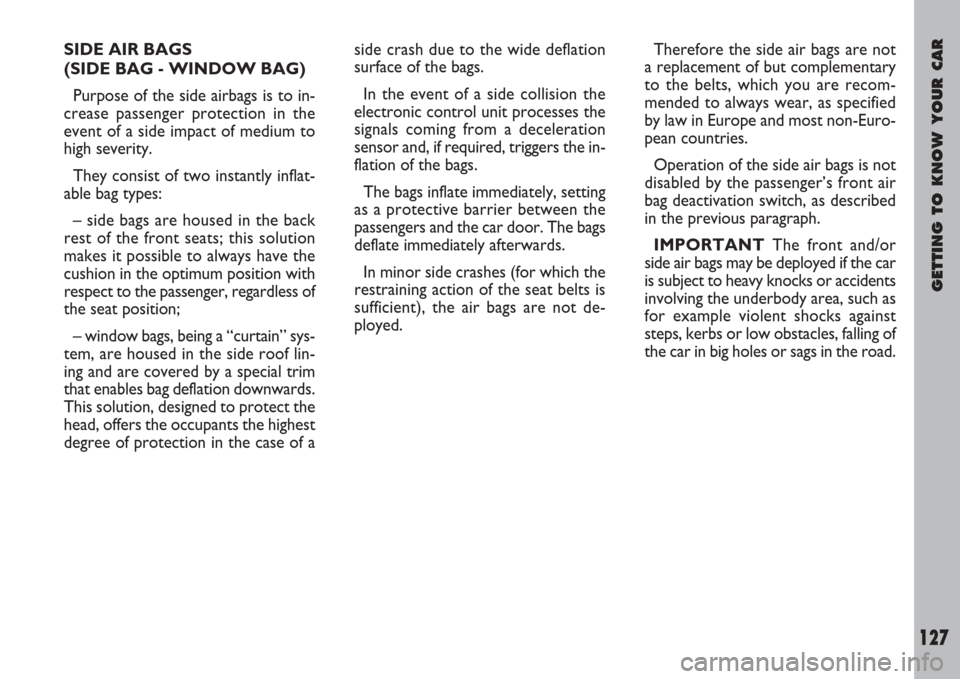
GETTING TO KNOW YOUR CAR
127
SIDE AIR BAGS
(SIDE BAG - WINDOW BAG)
Purpose of the side airbags is to in-
crease passenger protection in the
event of a side impact of medium to
high severity.
They consist of two instantly inflat-
able bag types:
– side bags are housed in the back
rest of the front seats; this solution
makes it possible to always have the
cushion in the optimum position with
respect to the passenger, regardless of
the seat position;
– window bags, being a “curtain” sys-
tem, are housed in the side roof lin-
ing and are covered by a special trim
that enables bag deflation downwards.
This solution, designed to protect the
head, offers the occupants the highest
degree of protection in the case of aside crash due to the wide deflation
surface of the bags.
In the event of a side collision the
electronic control unit processes the
signals coming from a deceleration
sensor and, if required, triggers the in-
flation of the bags.
The bags inflate immediately, setting
as a protective barrier between the
passengers and the car door. The bags
deflate immediately afterwards.
In minor side crashes (for which the
restraining action of the seat belts is
sufficient), the air bags are not de-
ployed.Therefore the side air bags are not
a replacement of but complementary
to the belts, which you are recom-
mended to always wear, as specified
by law in Europe and most non-Euro-
pean countries.
Operation of the side air bags is not
disabled by the passenger’s front air
bag deactivation switch, as described
in the previous paragraph.
IMPORTANTThe front and/or
side air bags may be deployed if the car
is subject to heavy knocks or accidents
involving the underbody area, such as
for example violent shocks against
steps, kerbs or low obstacles, falling of
the car in big holes or sags in the road.
Page 129 of 254
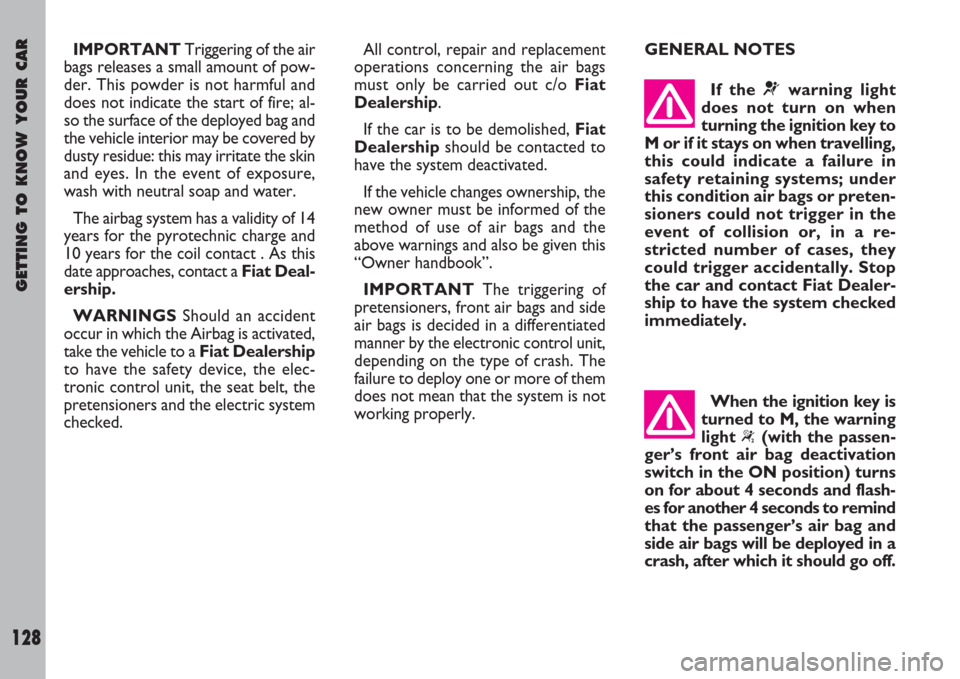
GETTING TO KNOW YOUR CAR
128
All control, repair and replacement
operations concerning the air bags
must only be carried out c/o Fiat
Dealership.
If the car is to be demolished, Fiat
Dealershipshould be contacted to
have the system deactivated.
If the vehicle changes ownership, the
new owner must be informed of the
method of use of air bags and the
above warnings and also be given this
“Owner handbook”.
IMPORTANTThe triggering of
pretensioners, front air bags and side
air bags is decided in a differentiated
manner by the electronic control unit,
depending on the type of crash. The
failure to deploy one or more of them
does not mean that the system is not
working properly.GENERAL NOTES
If the
¬warning light
does not turn on when
turning the ignition key to
M or if it stays on when travelling,
this could indicate a failure in
safety retaining systems; under
this condition air bags or preten-
sioners could not trigger in the
event of collision or, in a re-
stricted number of cases, they
could trigger accidentally. Stop
the car and contact Fiat Dealer-
ship to have the system checked
immediately.
When the ignition key is
turned to M, the warning
light
“(with the passen-
ger’s front air bag deactivation
switch in the ON position) turns
on for about 4 seconds and flash-
es for another 4 seconds to remind
that the passenger’s air bag and
side air bags will be deployed in a
crash, after which it should go off.
IMPORTANTTriggering of the air
bags releases a small amount of pow-
der. This powder is not harmful and
does not indicate the start of fire; al-
so the surface of the deployed bag and
the vehicle interior may be covered by
dusty residue: this may irritate the skin
and eyes. In the event of exposure,
wash with neutral soap and water.
The airbag system has a validity of 14
years for the pyrotechnic charge and
10 years for the coil contact . As this
date approaches, contact a Fiat Deal-
ership.
WARNINGSShould an accident
occur in which the Airbag is activated,
take the vehicle to a Fiat Dealership
to have the safety device, the elec-
tronic control unit, the seat belt, the
pretensioners and the electric system
checked.
Page 130 of 254
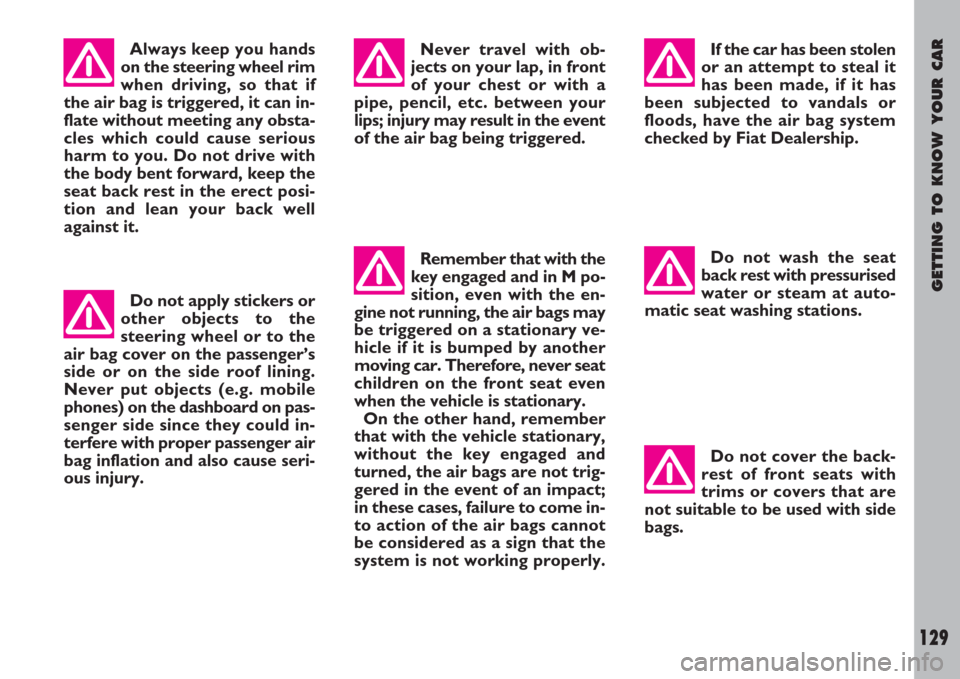
Remember that with the
key engaged and in M po-
sition, even with the en-
gine not running, the air bags may
be triggered on a stationary ve-
hicle if it is bumped by another
moving car. Therefore, never seat
children on the front seat even
when the vehicle is stationary.
On the other hand, remember
that with the vehicle stationary,
without the key engaged and
turned, the air bags are not trig-
gered in the event of an impact;
in these cases, failure to come in-
to action of the air bags cannot
be considered as a sign that the
system is not working properly.
GETTING TO KNOW YOUR CAR
129
Never travel with ob-
jects on your lap, in front
of your chest or with a
pipe, pencil, etc. between your
lips; injury may result in the event
of the air bag being triggered.If the car has been stolen
or an attempt to steal it
has been made, if it has
been subjected to vandals or
floods, have the air bag system
checked by Fiat Dealership.
Do not wash the seat
back rest with pressurised
water or steam at auto-
matic seat washing stations.
Do not cover the back-
rest of front seats with
trims or covers that are
not suitable to be used with side
bags. Always keep you hands
on the steering wheel rim
when driving, so that if
the air bag is triggered, it can in-
flate without meeting any obsta-
cles which could cause serious
harm to you. Do not drive with
the body bent forward, keep the
seat back rest in the erect posi-
tion and lean your back well
against it.
Do not apply stickers or
other objects to the
steering wheel or to the
air bag cover on the passenger’s
side or on the side roof lining.
Never put objects (e.g. mobile
phones) on the dashboard on pas-
senger side since they could in-
terfere with proper passenger air
bag inflation and also cause seri-
ous injury.